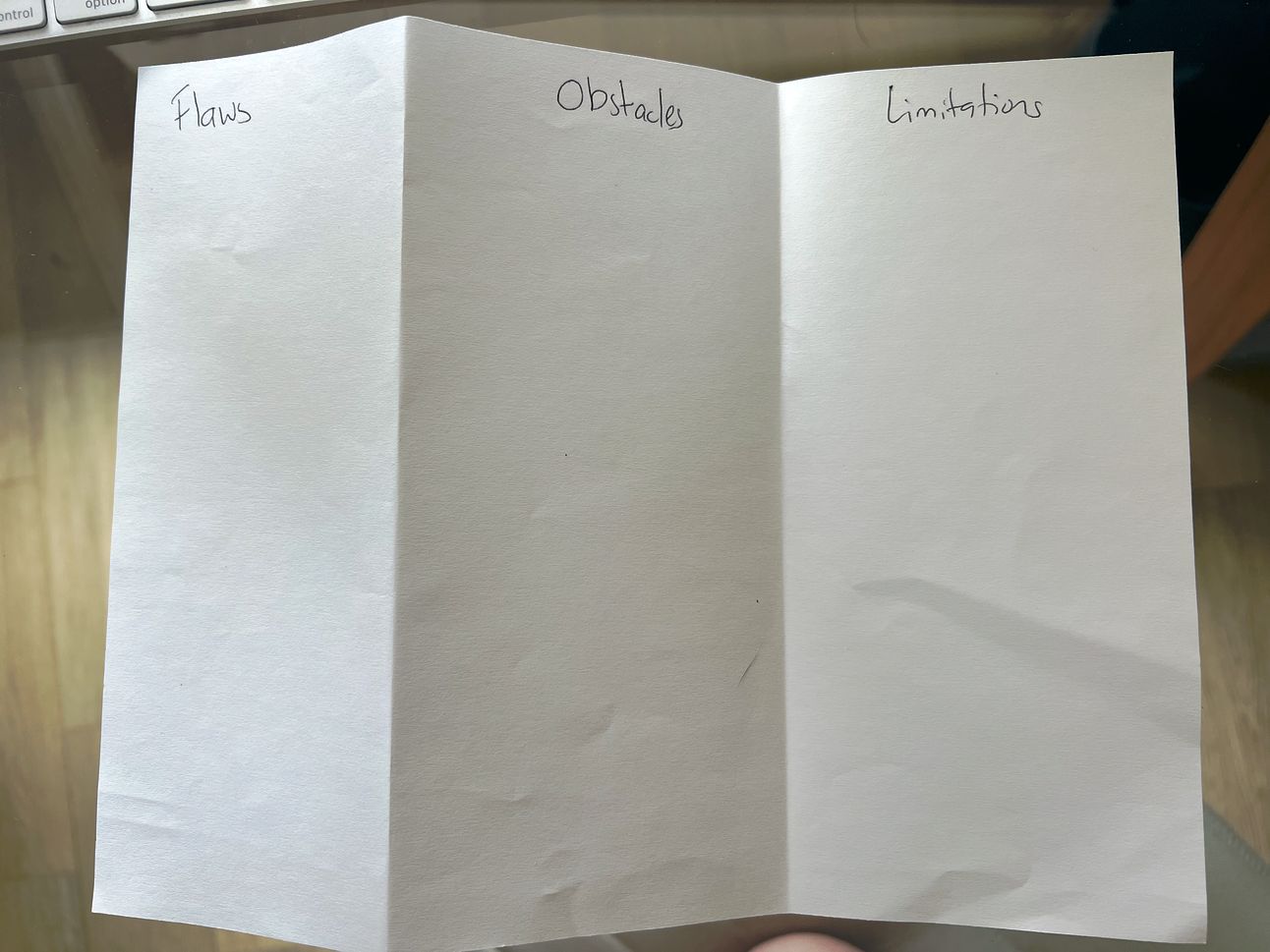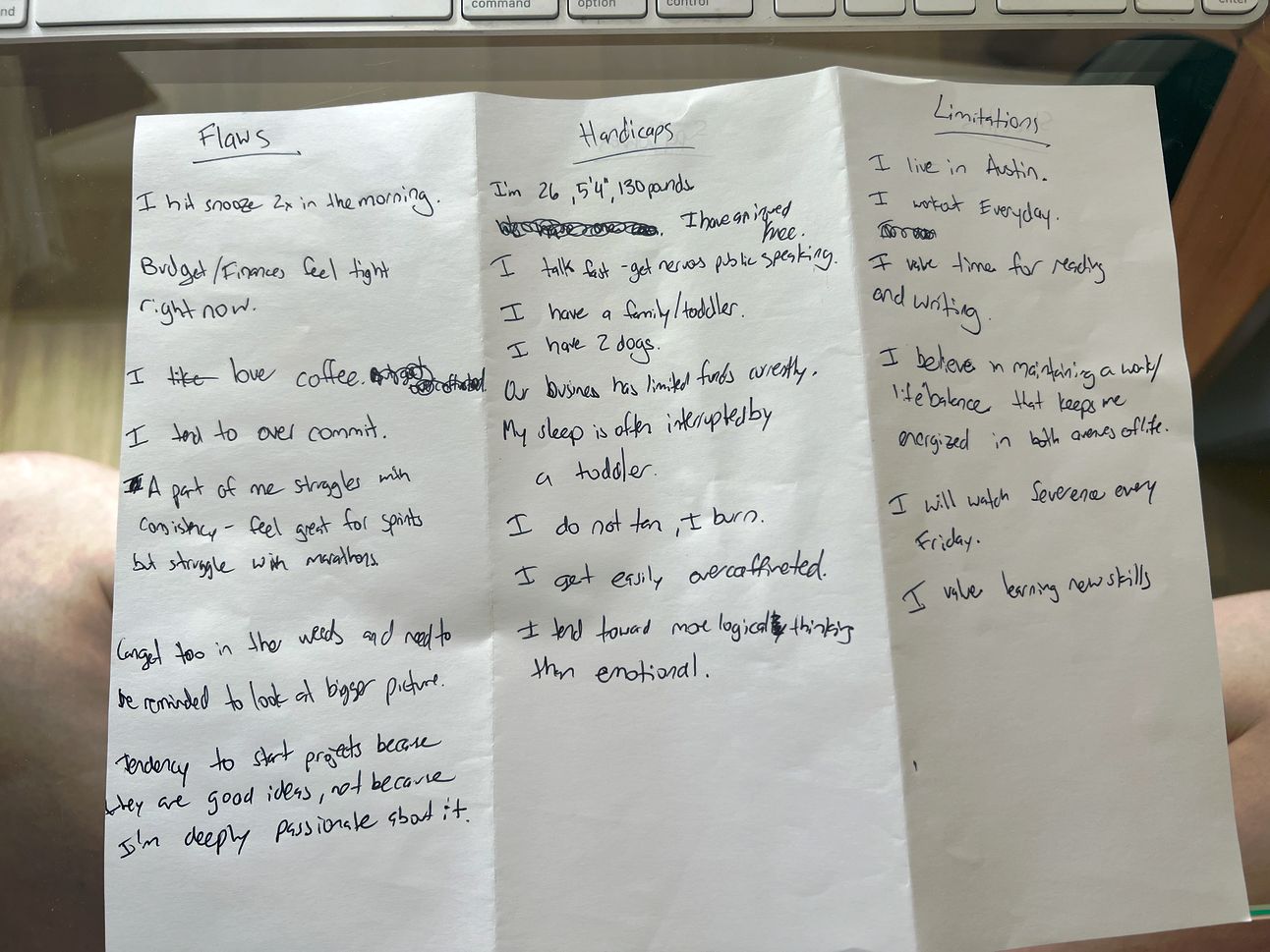- Higher Storyteller
- Posts
- Flaws, Obstacles, and Limitations
Flaws, Obstacles, and Limitations
A 3-Step Framework for Analyzing Anything
The best storytellers aren’t just writing fiction - they’re decoding human nature.
As Albert Camus put it:
“Fiction is the lie through which we tell the truth.”
Imagine you’re the protagonist of a novel. What are your biggest flaws? What are the obstacles you have to work around? And what are the things you could change but choose not to?
Turns out, this isn’t just a writing exercise - it’s a framework for navigating real life.
What if your personal flaws, obstacles, and limitations could be the blueprint for your success?
Character Analysis is Human Analysis
Prolific fantasy writer Brandon Sanderson has a host of free online lectures explaining his methodologies for world-building and character development.
One of his key insights? For characters to be likable, believable, and feel like "real" people, they must move along specific scales and possess distinct traits.
He talks about characters moving along likability and competence scales, each character having their own story arc, the power of character motivation, and ultimately how to establish empathy between readers and the characters he writes.
What’s fascinating is that frameworks like these - whether Sanderson’s or those of other storytelling experts - aren’t just about fiction. They’re about human nature. A well-constructed character mirrors the complexities, struggles, and motivations of real people - hence, why we get so emotionally attached to characters (real and imagined).
There’s always a degree of exaggeration and emphasis in storytelling to highlight character traits, but at its core, this magnifying glass is focused on the fundamental aspects of human nature.
The Framework: Flaws, Obstacles, and Limitations
Today, we are focusing on just one (of the many!) character-building frameworks Sanderson uses. He explains that characters must have these three elements. This helps them remain dynamic, provides guidelines of how they engage, and ultimately feel more human.
The Three Elements:
Flaws – Something that can change.
Obstacles (what he calls handicaps) – Something that cannot change and must be worked around.
Limitations – Something that could change, but the character (or person) doesn’t want to change.
Here’s where it gets interesting: This isn’t just a writing tool. It applies to real life.
Here’s how.
The Process: Using This Framework in Real Life
Try this simple exercise. You can use it for self-reflection, evaluating a business opportunity, or even understanding others better.
Step 1: Divide a Page into Thirds
Grab a blank sheet of paper and divide it into three columns labeled Flaws, Obstacles, and Limitations. Keep a spot at the bottom available for your notes and analysis. It should look something like this:

Step 2: List Them Out
Set a 2-minute timer and write as many Flaws as you can. Repeat for Obstacles and Limitations.
Tip: Try using "parts language" when writing your list. This means framing things in a way that acknowledges different aspects of yourself (e.g., "A part of me struggles with procrastination" instead of "I am lazy"). This helps you reflect on things more objectively and not to identify who you are with the action. (I will do a deeper dive on parts language in a future newsletter!)
Tip 2: Despite the negative connotations of these three words - Flaws, Obstacles, and Limitations - these aren’t always negative things. For example, a limitation may be that I value work/life balance. That is a good thing - or at least I think it is. This means that I am unwilling to work more than 40hrs a week so I can spend time with my family. It’s a limitation that I’ve placed.

Step 3: Analyze
Once done, ask yourself questions of this information. Examples:
What patterns stand out?
For example: Financial scarcity stands out as a theme in my Flaws and Obstacles. I can get curious around the origin of that fear and tendency.
What’s within your control to change, and what requires acceptance?
For example: I love coffee, yet I tend to get over caffeinated. This means I get to accept either a) coffee consumption in moderation or b) coffee jitters.
How does this impact your decisions, goals, or relationships?
For example: I value learning new skills, exercising daily, and reading. When looking for friendships, it helps to find people who share similar priorities. Or, take my current season of life: I have a family and dogs to care for, which naturally shapes my schedule and availability. Finding friends who are in a similar stage often leads to more shared understanding and activities that work for both of us.
For deeper reflection, check out this full list of analysis questions.
How to Use This Framework
1. Evaluating an Opportunity
This framework can be used to break down the risks and obstacles of a decision before taking action. For example, when planning a vacation.
Flaws – Things that could go wrong but can be managed (e.g., unpredictable weather, potential travel delays).
Obstacles – Fixed Obstacles (e.g., budget, time off work, travel restrictions).
Limitations – Preferences you could change but won’t (e.g., prioritizing comfort over adventure, choosing a familiar location over a new one).
This sounds like a more advanced pros/cons list, right? But I find it far more helpful because of the Limitations section of this list. These are essentially the things that you value, the things that you could give up, but choose not to. The limitations tells us a lot about a decisions and what our nonnegotiables truly are.
2. Understanding Others
Every person has their own Flaws, Obstacles, and Limitations. Recognizing these builds empathy and helps you navigate relationships more effectively.
Flaws – Areas where a person struggles but is actively working to improve.
Obstacles – Inherent traits or life circumstances that they cannot change.
Limitations – Beliefs, habits, or behaviors that they could change but have chosen not to.
Using this framework to better understand others helps you lead with empathy. It gives you insight not only into how someone operates but also whether your values align.
For example, if you keep seeing the “good” in someone, but they consistently fall short of what you expect, it might be worth asking: is this a limitation or a flaw?
A limitation is something they’ve accepted about themselves - something they aren’t trying to change. It may reflect a value they hold, even if it conflicts with yours. And if that’s the case, it’s not your job to convince them otherwise.
But a flaw is different. If someone is aware of it and actively working to grow through it, that’s a sign of alignment. You might just be seeing them mid-process - and that’s where your support and patience can matter.
3. Business & Leadership
Every team and organization faces internal and external challenges. This framework helps leaders diagnose issues and set realistic expectations.
Flaws – Inefficiencies that can be improved (e.g., unclear roles in a team, poor workflow processes).
Obstacles – Fixed Obstacles (e.g., regulatory requirements, budget limitations, staffing shortages).
Limitations – Areas of stagnation that aren’t being addressed OR areas of company culture that are valued
Leaders who can separate these factors make better strategic decisions and create a healthier work environment.
4. Sales & Negotiation
Understanding a customer’s Flaws, Obstacles, and Limitations can clarify their objections and hesitations.
Flaws – Problems they know and want to fix (e.g., inefficiencies, outdated processes, skill gaps).
Obstacles – Fixed Obstacles like budget limitations, compliance regulations, or approval processes.
Limitations – Issues they refuse to acknowledge or change (e.g., reluctance to adopt new technology, resistance to restructuring their business model). Or this could be positive limitations like they only want to work with vendors they know.
By identifying these elements in a sales conversation, you can tailor your approach to their unique needs and challenges.
5. Self-Reflection & Personal Growth
Perhaps the most valuable application of this framework is in self-awareness and personal development. When you break down your own Flaws, Obstacles, and Limitations, you gain a deeper understanding of your strengths, challenges, and personal roadblocks.
Flaws – Habits or behaviors that are holding you back but can be changed (e.g., procrastination, difficulty with time management, struggling with consistency).
Obstacles – Factors you must work around (e.g., chronic illness or financial Obstacles at this moment in time).
Limitations – Aspects of yourself that could change but that you’ve chosen not to (e.g., a fear of public speaking that keeps you from pursuing opportunities, reluctance to delegate tasks, a desire to work only 4 days a week, a decision to only eat organic whole foods.)
By identifying these elements, you gain clarity on:
What’s within your control to improve.
Where you need to adapt instead of resist.
How these factors impact your journey and decision-making.
Using this framework regularly can help you uncover patterns in your thinking and make intentional changes.
Closing Thoughts: Storytelling as a Self-Awareness Tool
This framework isn’t just a tool for writers - it's a way to make sense of our inner world.
When you map out your Flaws, Obstacles, and Limitations, you gain a clearer picture of what’s shaping your choices and what you’re carrying with you.
And that’s only half the story.
Soon, I’ll share a sister framework that flips this one on its head.
Instead of zooming in on our inner friction, we’ll explore our inner fuel through the lens of:
Abilities – what comes naturally to you, the skills and traits that make you uniquely effective
Allies – the tools, people, and systems that support your growth
Axioms – the foundational truths and core beliefs that guide your thinking, shape your decisions, and define what truly matters to you.
Together, these two frameworks offer a more complete view of who you are, what drives you, and how you navigate the world.
“The purpose of a storyteller is not to tell you how to think, but to give you questions to think upon."
Try the Flaws / Obstacles / Limitations exercise this week. See what patterns show up. Then meet me back here and we’ll shift the spotlight to your strengths.
Until then, Cheers!
-
Higher Storyteller 💖💫